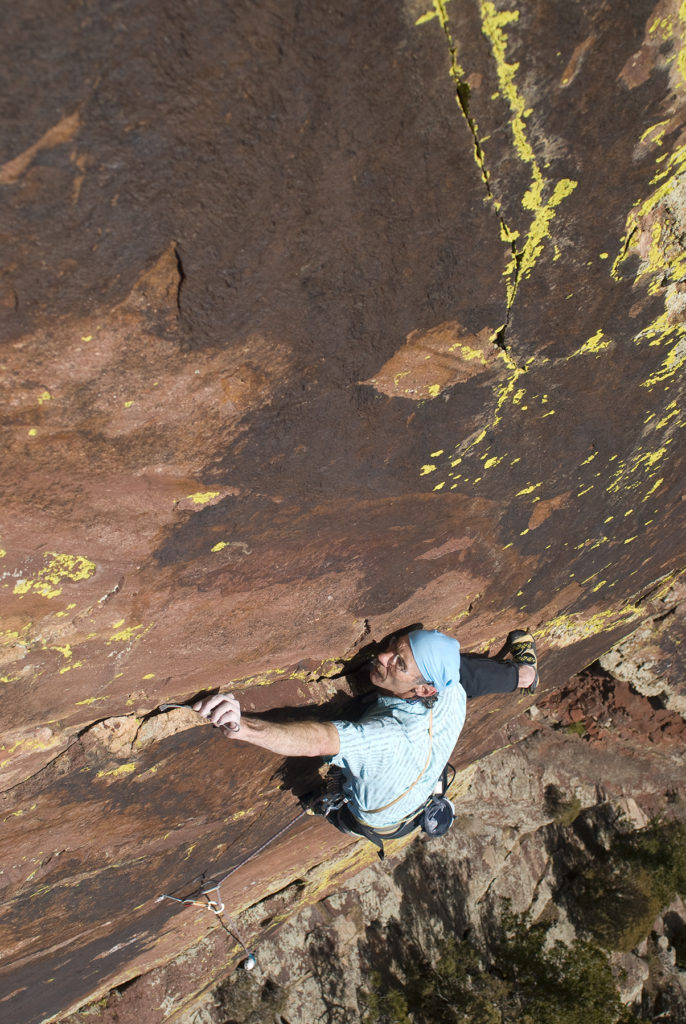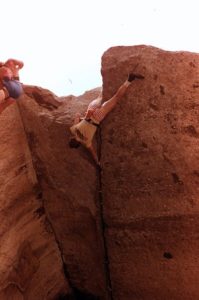
About two-thirds into the recent Oscar-nominated documentary Free Solo, Alex Honnold is balancing between two tiny rock nubs more than 1,000 feet above Yosemite’s valley floor; his feet are smeared against the granite, held by friction. He has no rope, no pack, no snacks — all accoutrements any other human would consider mandatory while ascending El Capitan, North America’s tallest vertical rock face. But Honnold doesn’t think he needs them.
His plan is to reach El Cap’s 3,200-foot summit, where a crew of friends and filmmakers await with celebratory offerings, before lunch.
But first, he has to get past what’s known as the “Boulder Problem” — a faith-and-friction move from the two rock nubs with practically non-existent foot holds, to grip a small protrusion the size of a kid’s nose, on which you then switch hands, shuffle your feet a few inches over, and kick out your foot in the hopes that it’ll land securely on the granite face opposite a nauseating mini-chasm with hundreds of feet of air gushing down below. And then, if you manage that, you push yourself up just enough to slip a few fingers into an overhead crack no bigger than a tube of toothpaste and move the rest of your body over the chasm. Without a rope.
He starts. Every palm in the movie theater sweats. He shuffles his feet over. People cover their eyes, forget their popcorn. He kicks his foot out and lets himself fall into the pad of his climbing shoe. Someone gasps in the front row. He slides his fingers into the crack. A pin drop would now be audible in the dark auditorium. Honnold looks directly at the camera, a remote system that Jimmy Chin, the famed National Geographic cinematographer and decorated climber, has set up a few feet left of the move. Honnold flashes a smile. He knows in that moment, with the hardest singular move of the route now under his belt, that instead of death, he is going to achieve “one of the great athletic feats of any kind, ever,” as the New York Times would later write on its front page. He reaches the top, and everyone — fellow professional climbers and curious, everyday people venturing to the movie theater alike — relaxes.
But rewind for a moment, to 25 years ago. It’s 1993, and the Californian superstar Lynn Hill makes the first “free ascent” of The Nose, El Cap’s most iconic route. For years, the best climbers in the world had been speculating whether or not the route could ever be done without the aid of equipment, so when Hill reached the summit that day, she made climbing history as the first person to use gear for nothing more than protection, her hands and feet doing all of the work to move up the thousands of vertical feet.
“I didn’t get near the attention,” Hill says recently of Honnold’s free solo. “I didn’t get, you know, whatever commercials. … No car company ever came to me because I was always so far outside the norm. I mean the fact that a woman did something before a man should have been a much bigger thing; the #MeToo movement would’ve been all over that.”
Both Hill’s free ascent and Honnold’s free solo were visionary ascents that now bookmark chapters in climbing’s history; both reevaluated the capabilities of human physical and mental fortitude, redefining the future of climbing’s potential. One just happened at a point in time when the thought of climbing having anything to do with national news headlines, IMAX movies, Oscar nominations, multi-million-dollar sponsors, the Olympics, or festivals that sell out in under two minutes would have been crazier than a mountaineer’s delusional gibberish after five days without food on a mountain face.
Twenty-five years ago, climbing was just something that white guys with too much time on their hands did for fun. Women like Hill were minorities in the U.S.’s three main climbing communities — Yosemite, Boulder and “the Gunks” in New York. “Training” mostly consisted of just climbing, a lot, outside. People from everywhere migrated to Boulder, which had become the epicenter of cutting-edge climbing.
Ruminating on how the sport has evolved over the past quarter-century, Roger Briggs — the legendary lifelong Boulder resident with thoughtful stormy eyes who climbers can thank for his first free ascents of classic Eldorado Canyon lines and the hardest routes up the vertical east face of Longs Peak, known as “The Diamond” (which, since age 16, he’s climbed more than 100 times) — considers the span between Hill’s and Honnold’s accomplishments as a measure of the sport’s progress.

“OK, from 25 years ago, you can say it’s gone from Lynn to Alex,” he says. “Climbing is such a classic example of what people think is possible, and then someone shatters that.” One feat might seem more insane than the other, but neither were ever a given for the sport.
So how did we get from Hill to Honnold? Namely, the advent of climbing gyms and social media, both Hill and Briggs point out, two innovations that, on one hand, helped people get stronger and secure professional sponsorships, but, on the other hand, also led to the epic popularity boom the climbing industry grapples with today.
Climbing’s roots dig back before World War II, but most major and modern gear advancements happened between the ’60s and ’80s, with a code of ethics developing in tandem. This set up the ’90s for a process of technique refinement and the exploration of human limits. The Boulder Rock Club, an indoor climbing facility, opened its doors in 1991, providing a space for climbers to perfect their training regiments, and for a new generation of kids to get involved.
Since then, all disciplines of climbing — traditional, sport and bouldering — have exploded in popularity. Professional climbers/Boulder County residents like Sasha DiGiulian, Daniel Woods and Jon Cardwell, among many others, have tens of thousands, if not hundreds of thousands, of followers on social media. Documentaries are now commonplace, and youth climbing teams continue to grow.
No one really knows how many climbers live in Boulder County at the moment, but with seven public climbing gyms in Longmont, Louisville and Boulder alone, it’s safe to say a lot. Venture to Boulder or Eldorado Canyons on the weekend, and it’s like the entire 5 p.m. gym crowd is out on a field trip. Briggs bets there are at least 10,000 climbers; in 2011 he founded the Boulder Climbing Coalition to help channel climbing stewardship opportunities, and he says at least 2,000 people are on the organization’s email list.

Malcolm Daly, who moved to Colorado for college (cough, climbing) in the ’70s and never left, founded the climbing company Trango and remembers the early days of Rocky Mountain National Park (RMNP), back when the overflow parking lots weren’t necessary and only a special occasion instigated a line of cars at the visitor entrance. “When I moved here … sport climbing had just been invented,” he says. “Boulder Canyon was a trad climbing area just like Eldorado is.”
In those days, “We could go find a cliff that hadn’t been climbed before in RMNP and do routes on it,” Daly says. “Those cliffs have pretty much all been found. They have routes on them and they’re in guidebooks now.”
Gary Neptune, founder of Neptune Mountaineering, remembers the early days, too, hiking to a crag in Boulder Canyon, at least twice finding naked women sunbathing. “And that’s how few people there were. They were just down by the river just out of sight of everybody else,” he says. Today, you’re lucky if you find a parking slot after 10 a.m.
While the epic surge of climbing’s popularity has frustrated some, to others it’s a symbol of the community’s success. Hill says, “It’s just a reality.” Since she moved to Boulder in the early 2000s, she’s watched local crags grow too crowded to even get on a route at times. “It’s unfortunate. [But] I’m glad because I feel like finally the world is waking up. They understand how cool climbing is and they understand how important it is to give back to the environment, give back to humanity.”

Daly says, “Maybe we have the same number of men, but many more women… and that’s a good reason [why there are more climbers], by the way.” He sees adventure opportunities simply changing, now that most of the terrain around Boulder has been climbed. “People are combining things. They’re doing three Diamond routes in a day, or big ridge traverse from Meeker all the way up to Notchtop; they’re finding new ways to have adventures and I think that’s going to continue. I think that’s one of our inherent things being human beings: we seek adventure, we want new experiences.”
This month Free Solo began its second round of screenings in the U.S., this time competing for an Academy Award. Next year, climbing makes its Olympic debut, a handful of Boulderites like Margo Hayes and Brooke Raboutou, both raised on local outdoor rock and at Boulder’s climbing gyms, competing for spots on Team U.S.A.
As climbing fever spreads, with people being introduced at gyms in places without outdoor rock or inspired by social media stars and movies like Free Solo, “A lot of them are going to want to go outdoors and come here,” Briggs says, just like they have for decades. “Boulder was the center at [climbing’s inception], and still is.”














